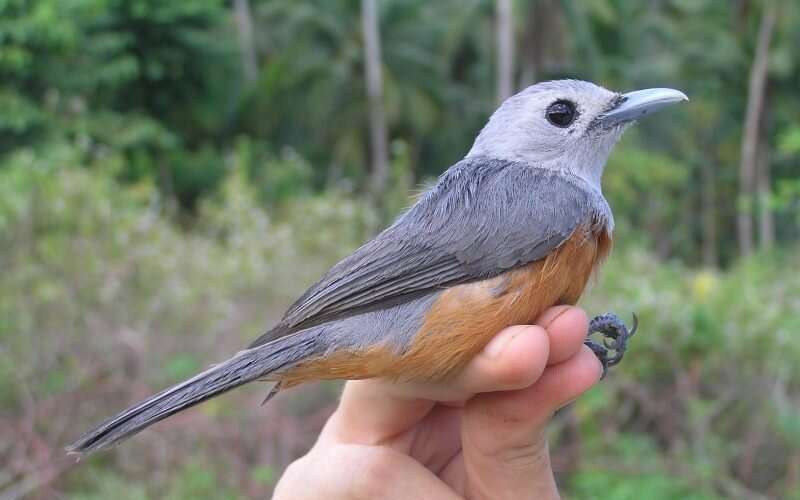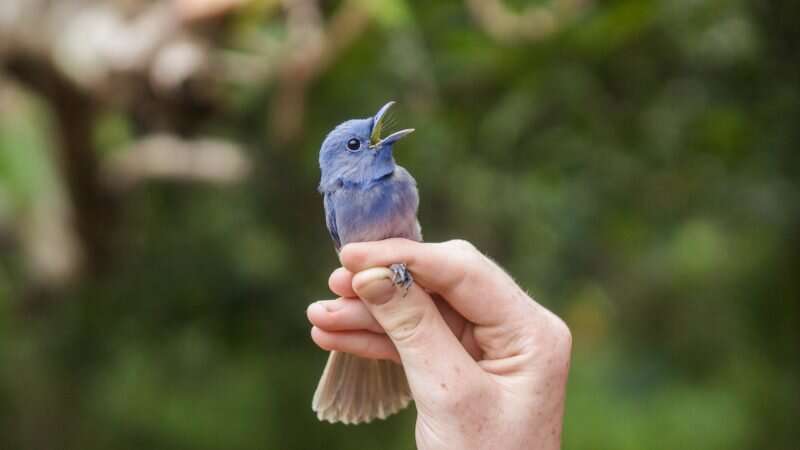New research on famous 'supertramp' birds offers fresh evolutionary insights

Beautiful "supertramp" birds in Southeast Asia are providing unique insights into how evolution is linked to flight ability and competition. New research testing decades-old theories has confirmed that the isolating effects of islands impact the evolution of even the species most accomplished at colonizing them—and in some surprising ways.
The zoologists behind the study, from Trinity College Dublin's School of Natural Sciences, sequenced DNA and took measurements from Island Monarchs (Monarcha cineracens), which are widespread birds that have been studied by evolutionary biologists for decades. They compared these to a related bird species, the Pale-blue Monarch, which lives in the same region but has a different lifestyle.
Among the eye-opening findings is the discovery that these birds settle down more readily than would be expected—once they have colonized an island they tend to stay there rather than searching for others.
In combination, the work confirms there is still much we don't know about these birds, despite their historic importance to scientific theory.
Fionn Ó Marcaigh, first author on the paper and a Ph.D. Candidate in Trinity's School of Natural Sciences, said:
"This study was a great opportunity to work with one of biogeography's 'star species.'" The Island Monarch was studied by famous scientist and geographer Jared Diamond in the 1970s, when he saw that they occurred on small islands across a wide range but were entirely missing from larger islands. He named species with this kind of distribution 'supertramps,' hypothesizing that they essentially evolved into specialist island colonizers in response to their small islands being so unstable. This hypothesis has been influential ever since, but now we're able to test it using modern genetic methods and help to evolve it further.

"We found that even though the Island Monarch is clearly good enough at flying to reach these islands in the first place, it doesn't maintain this dispersive lifestyle after colonization. This causes the island populations to diverge from one another, to the point that the Island Monarch in our study region is probably a different species to the one Diamond worked with, even though they look the same to the eye.
"Our statistical analyses indicate that this genetic divergence is linked to the size, elevation, and isolation of the islands, but we found no evidence that the monarchs get physically worse at flying between islands. They just choose to stop doing so.
"It goes to show how important these island regions are in the evolution of new species. Once a bird is living on these little islands so far from everywhere else it's just a matter of time before they start to evolve into something new.
"It seems even supertramp species have to settle down eventually."
The research, completed with the support of the Irish Research Council and collaborators in Universitas Halu Oleo, has just been published in Frontiers of Biogeography, the journal of the International Biogeography Society.
The study adds new knowledge to the field of biogeography, the study of the distribution of species through space and time. Biogeography has been an important part of evolutionary biology since the very beginning as both Charles Darwin and Alfred Russel Wallace based their theories on it.
More information: Fionn Ó Marcaigh et al, Tramps in transition: genetic differentiation between populations of an iconic "supertramp" taxon in the Central Indo-Pacific, Frontiers of Biogeography (2022). DOI: 10.21425/F5FBG54512
Provided by Trinity College Dublin




















